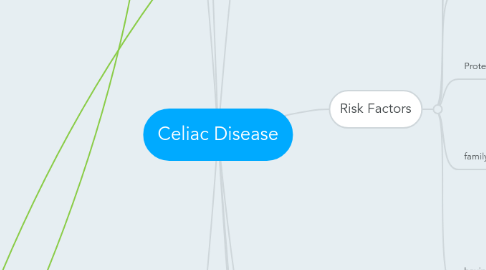
1. Pathogenesis
1.1. tTG autoantibodies
1.1.1. tTG binds to gliaden (fragment of gluten)
1.1.1.1. antigen presenting cells recognize whole complex as foreign
1.1.1.1.1. antibodies (IgA) produced to tTG-gliaden complex
1.2. Genetics
1.2.1. HLA-DQ2/DQ8
1.2.1.1. 2 copies of either =10% risk
1.2.1.2. 1 copy of either =3% risk
1.2.1.3. HLA-DQA1/DQB1
1.2.1.3.1. HLA-DQA1
1.2.1.3.2. HLA-DQB1
1.2.1.3.3. involved in self-tolerance and autoimmunity
1.2.1.3.4. heterodimer binds to gliaden
1.2.1.4. necessary but not sufficient for development of disease
1.2.1.4.1. 30% of population has vulnerable variants, but only 3% develop celiac disease
1.3. involves innate and adaptive immune system
1.4. Gluten fragments bind to HLA-DQ2/DQ8 molecules
1.4.1. T cells responsive to complexes are activated
1.4.1.1. proinflammatory CD4 T cells present in lamina propria of small intestine
1.4.1.1.1. pro inflammatory cytokines released
2. Risk Factors
2.1. female
2.1.1. ratio of 2.9:1 (women:men)
2.2. introduction of gluten before 4 months of age
2.3. birth by caesarean section
2.3.1. due to lack of vaginal bacteria seeding GI tract?
2.4. stressors such as illness, pregnancy, trauma?
2.5. Protective Factors
2.5.1. Vaginal Birth
2.5.2. late introduction of gluten
2.5.3. breastfeeding
2.5.4. male
2.5.5. non-white
2.6. family member with Celiac Disease
2.7. having another autoimmune disease
2.7.1. Hashimoto's Thyroiditis
2.7.2. Sjogrens Syndrome
2.7.3. Rheumatoid Arthritis
2.7.4. Type 1 diabetes
2.7.5. Psoriasis
2.7.6. Systemic lupus erythematosis
2.7.7. Addisons
3. Incidence/Prevalence
3.1. in the US: 1 in 133
3.2. 1 in 22 if you have a first degree relative with Celiac Disease
3.3. 1 in 22 if you have a second degree relative with Celiac Disease
3.4. 1 in 236 African-, Hispanic-, Asian-Americans
3.5. increased prevalence of Celiac disease with Down Syndrome (5-12%) Turner Syndrome (3%), Williams Syndrome (3-10%), Selective IgA deficiency (2-10%)
3.6. no age predilection for onset of disease.
4. Diagnostics
4.1. Gold Standard: Duodenal/jejeunal biopsy via endoscopy
4.2. Must test before gluten free diet is begun
4.3. Blood Tests
4.3.1. tissue trasglutaminase (tTG)
4.3.2. endomysium (EMA
4.3.3. deamidated gliadin peptide (DGP
4.3.4. total IgA
4.3.4.1. IgA deficiency can result in false negative EMA/tTG
4.4. Gluten Challenge
4.4.1. after all symptoms have resolved, reintroduce gluten to confirm
4.5. Post diagnosis diagnostics
4.5.1. DEXA scan
4.5.2. CT
4.5.3. x-ray
4.5.4. Vitamin deficiency
4.5.5. screen for other auto immune conditions
5. Treatments
5.1. Experimental treatments
5.1.1. Zonulin inhibitors (Larazotide)
5.1.2. Peptides to block binding of DQ2/DQ8
5.1.3. tTG inhibitors
5.1.4. cytokine blockers
5.1.5. inhibition of leukocyte adhesion
5.1.6. oral proteases
5.1.7. gluten sequestering polymers
5.1.8. vaccine (Nexvax2)
5.2. GLUTEN FREE DIET FOR LIFE!
5.2.1. No:
5.2.1.1. wheat
5.2.1.1.1. Spelt
5.2.1.1.2. triticale
5.2.1.1.3. semolina
5.2.1.1.4. duram
5.2.1.1.5. kamut
5.2.1.2. barley
5.2.1.3. Rye
5.2.1.4. contaminated oats
5.2.2. FDA deems <20ppm of gluten to be "gluten free"
5.2.3. avoid foods processed in facilities that process wheat products
5.2.4. gluten free diet for 5 years reduces the risk of intestinal cancer back to that of the non celiac population
5.3. treat secondary problems
5.3.1. vitamin deficiencies
5.3.1.1. supplementation
6. Clinical Manifestations
6.1. other symptoms
6.1.1. fatigue
6.1.2. neurological
6.1.2.1. ADHD
6.1.2.2. Seizures
6.1.2.3. peripheral neuropathy
6.1.3. joint pain
6.1.4. skin rash
6.1.5. amennorrhea
6.1.6. weight loss
6.1.7. bruising
6.1.8. peripheral edema
6.1.9. orthostatic hypertension
6.1.10. osteoporosis
6.2. Gastrointestinal Symptoms
6.2.1. greasy/fatty stool (steatorrhea)
6.2.2. abdominal distension/bloating
6.2.3. diarrhea
6.2.3.1. 85% of people with celiac disease
6.2.4. excess gas
6.2.5. constipation
6.2.6. lactose intolerance
6.3. microscopic
6.3.1. villous crypt hypertrophy
6.3.2. villous blunting/atrophy
6.3.3. inflammatory changes of intestinal villi
6.3.4. reduction in duodenal folds
6.3.5. scalloping of duodenal folds
6.3.6. mucosal fissures
6.4. vitamin/mineral deficiencies due to malabsorption
6.4.1. iron
6.4.1.1. anemia
6.4.2. B vitamins
6.4.3. vitamin D
6.4.4. zinc
6.4.5. calcium
6.4.5.1. chvostek's sign
6.5. long term, without treatment
6.5.1. B/T cell lymphoma
6.5.2. non-hodgekins lymphoma
6.5.3. small intestinal adenocarcinoma
6.5.4. esophageal cancer
6.5.5. thyroid cancer
6.5.6. pregnant mother without treatment
6.5.6.1. preterm birth
6.5.6.2. low birth weight
6.5.6.3. miscarriage
6.5.6.4. growth retardation
6.5.7. children
6.5.7.1. growth restriction
6.5.7.2. behavioral difficulties
6.5.7.3. learning difficulties
6.5.7.4. irritability
6.5.7.5. failure to thrive
6.5.7.6. delayed puberty
6.5.8. other, adult
6.5.8.1. infertility
6.5.8.2. migraines
6.5.8.3. depression
6.5.8.4. ADHD
6.5.8.4.1. exacerbation
6.5.8.5. Seizures
6.6. May develop at any age
6.6.1. average time of diagnosis is 6-10 years post development of symptoms
6.6.2. most common decade of diagnosis is 40's
7. Non-celiac Gluten Sensitivity
7.1. T-cell mediated
8. Categories of Celiac Disease
8.1. silent
8.2. classic
8.3. non-classic
8.3.1. dermatitis herpetiformis
